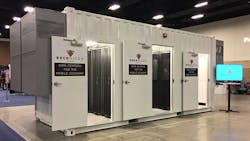Edge Computing 101: A Guide to the Emerging Players
Edge computing is a hot topic right now, and holds the potential to alter the geography of the data center industry, as infrastructure adapts to support the Internet of Things, virtual reality and connected cars.
As these technologies develop and gain traction, a number of companies are targeting the challenges address challenges and opportunities of deploying capacity at the edge of the network. Here’s our guide to the new players on the edge, which includes both startups and established names in the data center sector.
First, for those just getting up to speed, here’s a primer on the edge computing trend, which DCF has been tracking for several years and identified as a key industry theme for this year:
The Year Ahead: Edge Computing Creates Opportunity in 2017: Edge computing is evolving beyond caching, and will require more compute power and intelligence to manage the movement of data, say analysts, who predict this will create business opportunities for data center providers in 2017.
Cabinets inside an EdgeConneX data center. The company has built a network of data centers focused on the needs of edge content providers. (Image: EdgeConneX)
Data Companies Pursuing Edge Strategies
Here’s a look at our recent coverage of companies announcing strategies targeting the edge computing opportunity:
Startup EdgeMicro Plans Network of Tower-Based Micro Data Centers: Data center startup EdgeMicro is the latest in a series of ventures targeting the market for edge computing, and plans to roll out more than 500 micro data centers at cell towers.
Vapor IO Teams with Tower Titan on Edge Data Center Network: Data center startup Vapor IO will team with Crown Castle to deploy Project Volutus, a distributed network of small data centers at the base of telecom towers.
[clickToTweet tweet=”Data center industry to address challenges and opportunities of deploying capacity at the edge of the network.” quote=”Data center industry to address challenges and opportunities of deploying capacity at the edge of the network.”]
DataBank Plans Network of Micro Data Centers at Cell Towers: DataBank and Vertical Bridge are partnering to build a network of micro data centers at the base of cell towers to support demand for edge computing.
Vertical Bridge has teamed with DataBank on a project to deploy micros data centers at the base of telecommunications towers, like this one. (Photo: Vertical Bridge)
Switch Refines MOD Data Center Design for Edge, Smart Cities: Switch has updated its MOD Data Center Design to package its innovations in a smaller form factor, allowing it to expand beyond hyperscale projects to enterprise, edge and smart cities infrastructure.
DartPoints Brings its Micro Data Centers to the Edge: DartPoints, which launched in 2014 with an ambitious vision to build a national network of micro data centers, is planning facilities in five new markets.
DataStation: Bringing Servers to the Heart of the Grid: The SRP DataStation places modular data centers from BASELAYER at the bulk transmission lines that represent the fast lane of the power grid, allowing them to operate without a UPS or generator.
The Fog Layer and Other Demand Wildcards
In coming weeks we’ll be writing more about the various factors that will impact how the edge computing market develops. In the meantime, here are several recent stories that highlight some wrinkles that illustrate the opportunities for new deployment models, but also raise interesting questions about what type of hardware will handle edge requirements.
New Chips, Software Shift Workloads from Cloud to Mobile Devices : Advances in hardware and software are bringing the computing power of the cloud into devices in our pockets, allowing smartphones and IoT devices to run AI neural networks and other data-intensive processing.
Supercomputing Moves to the Edge with AI-Guided Drones : Avitas Systems’ drone inspection service is bringing AI data-crunching to remote locations with the NVIDIA DGX Station “supercomputer in a box.”
To Download the Data Center Frontier Special Report on Edge Computing, courtesy of BASELAYER – CLICK HERE.
Explore the evolving world of edge computing further through Data Center Frontier’s special report series and ongoing coverage.


